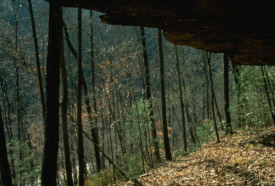The Emory

The Emory rises at the foot of mountains at
the deserted mining town of Mahan, northwest of Wartburg. For
the first few miles, the river is very small and is barely
large enough to boat when the flow is high.
The headwater system is small, and runoff is very fast.
The upper section of the river runs down a rather
unattractive mountain filled with roads, a deserted railroad,
the remains of mining activity, and deserted farms and houses.
The first few miles have rapids to Class II.
The stream then becomes sluggish with brushy banks.
The stream flows beneath US 27 and 1 ½
miles further downstream, it is crossed by as county road
bridge. From here to the confluence with the Obed, the overall
gradient is about 23 ft. / mile.
However the last 1 ½ miles drop a total of almost 70
feet. Difficulty is Class II-III.
 Below
the junction with the Obed, there is a succession of small
Class III rapids with a gradient of 10 ft. / mile.
One mile below the junction with the Obed, Nemo Bridge
spans the river. This bridge is on the Wartburg-Catoosa
Wildlife Management Area road. Below
the bridge, the river turns sharply left into a Class II-III
rapid, Nemo Rapid.
Below
the junction with the Obed, there is a succession of small
Class III rapids with a gradient of 10 ft. / mile.
One mile below the junction with the Obed, Nemo Bridge
spans the river. This bridge is on the Wartburg-Catoosa
Wildlife Management Area road. Below
the bridge, the river turns sharply left into a Class II-III
rapid, Nemo Rapid.
Between Nemo Rapid and the junction with
crooked Fork creek (left side) there are several Class II
rapids. The distance is
4 miles. Two miles
beyond Crooked Fork creek, camp Austin crosses the Emory.
Below this bridge is a Class II rapid.
Approximately ¼ mile below the bridge, Crab Orchard
Creek enters on the right. Crooked
Fork Creek, after sufficient rain, offers of the most
difficult and demanding runs on the Obed-Emory System.
Crab Orchard Creek has excellent scenery and non-stop
Class II-III whitewater.
The Emory become quite quiet with long pools
as Oakdale is approached. Below Oakdale Bridge, the gradient decreases to 5 ft. /
mile. The are mild rapids all the way to Harriman on the
backwaters of Watts Bar Lake.
The
Emory is the only stream in the systems that is turbid and
silt from agricultural and strip mine runoff. However, below the junction with the Obed, this effect
is not quite so bad because much of the much larger
volume of water contributed by the Obed.
